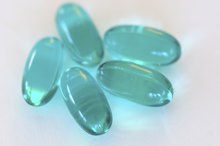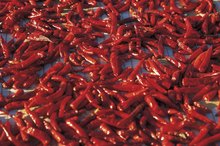The Best Over the Counter Medicine for Sore Muscles
Sore muscles occur with injury, overuse or when beginning a new intense physical activity. Sore muscles can be the first sign of positive improvement after exercise, but may also be a sign of serious muscle damage if the soreness is severe. In both cases, however, OTC, or over-the-counter medications, ice therapy and rest are generally all that is needed to treat sore muscles.
If you are experiencing serious medical symptoms, seek emergency treatment immediately.
Acetaminophen
Acetaminophen is effective because it reduces the chemical signals in the brain that are related to pain that is associated with sore muscles 1. Acetaminophen is generally a safe OTC medication, but should not be taken if a patient has liver disease 1. Furthermore, a healthy patient should take no more than 1 gram per dose and should avoid taking more than 4 grams per day to avoid liver damage. A patient should seek emergency medical treatment if he experiences dark stools, stomach pain, jaundice or dark urine.
Naproxen Sodium
How to Remove Capsaicin From Skin
Learn More
Naproxen sodium is a nonsteroidal anti-inflammatory drug, or NSAID, that reduces chemical signals in the body that are related to pain and inflammation associated with sore muscles. Taken as directed, naproxen sodium is safe and effective. However, a patient should be aware of possible side effects that include stomach pain, dark urine, clay-colored stools and heart problems. A patient experiencing any of these side effects should seek emergency medical treatment to avoid serious complications.
- Naproxen sodium is a nonsteroidal anti-inflammatory drug, or NSAID, that reduces chemical signals in the body that are related to pain and inflammation associated with sore muscles.
- However, a patient should be aware of possible side effects that include stomach pain, dark urine, clay-colored stools and heart problems.
Capsaicin Cream
Capsaicin cream is a topical OTC medication that can be used to treat pain associated with sore muscles. Capsaicin, a derivative of chili peppers, reduces a chemical signal related to pain when applied topically to the skin over the sore muscle. A patient must be warned that capsaicin cream causes a burning sensation for 15 to 20 minutes after application. Once the burning sensation subsides, a patient should note an improvement in pain symptoms. Furthermore, capsaicin cream must be used for a few days to achieve the optimum effect. No side effects are associated to capsaicin cream, which makes this product a safe medicine to use for sore muscles.
- Capsaicin cream is a topical OTC medication that can be used to treat pain associated with sore muscles.
- A patient must be warned that capsaicin cream causes a burning sensation for 15 to 20 minutes after application.
Related Articles
References
- MedlinePlus: Acetaminophen
- Fattori V, Hohmann MS, Rossaneis AC, Pinho-ribeiro FA, Verri WA. Capsaicin: current understanding of its mechanisms and therapy of pain and other pre-clinical and clinical uses. Molecules. 2016;21(7). doi:10.3390/molecules21070844
- Derry S, Moore RA. Topical capsaicin (low concentration) for chronic neuropathic pain in adults. Cochrane Database Syst Rev. 2012 Sep 12;(9):CD010111. doi:10.1002/14651858.CD010111
- McAlindon TE, Bannuru RR, Sullivan MC, et al. OARSI guidelines for the non-surgical management of knee osteoarthritis. Osteoarthritis Cartilage. 2014 Mar;22(3):363-88. doi:10.1016/j.joca.2014.01.003
- Gagnier JJ, Oltean H, van Tulder MW, Berman BM, Bombardier C, Robbins CB. Herbal medicine for low back pain: A Cochrane review. Spine (Phila Pa 1976). 2016 Jan;41(2):116-33. doi:10.1097/01.brs.0000249525.70011.fe
- Siemens W, Xander C, Meerpohl JJ, et al. Pharmacological interventions for pruritus in adult palliative care patients. Cochrane Database Syst Rev. 2016;11(11):CD008320. doi:10.1002/14651858.CD008320.pub3
- Moon AM, Buckley SA, Mark NM. Successful treatment of cannabinoid hyperemesis syndrome with topical capsaicin. ACG Case Rep J. 2018;5:e3. doi:10.14309/crj.2018.3
- Carey ET, As-Sanie S. New developments in the pharmacotherapy of neuropathic chronic pelvic pain. Future Sci OA. 2016;2(4):FSO148. doi:10.4155/fsoa-2016-0048
- McMillan R, Forssell H, Buchanan JA, Glenny AM, Weldon JC, Zakrzewska JM. Interventions for treating burning mouth syndrome. Cochrane Database Syst Rev. 2016;11(11):CD002779. doi:10.1002/14651858.CD002779.pub3
- Loflin BJ, Westmoreland K, Williams NT. Vulvodynia: A review of the literature. J Pharm Technol. 2019;35(1):11-24. doi:10.1177/8755122518793256
- Derry S, Rice AS, Cole P, Tan T, Moore RA. Topical capsaicin (high concentration) for chronic neuropathic pain in adults. Cochrane Database Syst Rev. 2017;1:CD007393. doi:10.1002/14651858.CD007393.pub4
- Baranidharan G, Das S, Bhaskar A. A review of the high-concentration capsaicin patch and experience in its use in the management of neuropathic pain. Ther Adv Neurol Disord. 2013;6(5):287-97. doi:10.1177/1756285613496862
Writer Bio
As a physical medicine and rehabilitation physician I have extensive experience in musculoskeletal/neurological medicine that will benefit the network.









